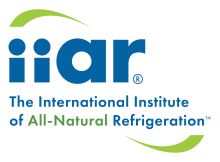Introduction and Important Information about this Tool
With the many recent world-wide changes in refrigerant use and phasedown regulations, the need to evaluate your currently used and future use refrigerant is rising. IIAR has built a fact-based tool that will help users make an informed decision regarding refrigerant selection. We have gathered pertinent information about each refrigerant that can help a user decide which refrigerant is best for their application and their operational situation. The information contained in this evaluation tool was collected from open sources including but not limited to the web sites of ASHRAE, various refrigerant manufacturers, and the EPA. We have made every attempt to provide accurate and current information.
Verifiable physical data and characteristics, and government actions, provide the technical information basis of this tool. However, one very important component of the evaluation of a refrigerant is its performance efficiency. This can be more difficult to assess and depends significantly on the application, equipment, and complete system used to determine a relative efficiency. Various methods to evaluate efficiency were considered. Energy performance presented by this tool is calculated with the operating consumed power divided by the refrigerating capacity produced, or brake-horsepower per ton of refrigeration (BHP/TR) in U.S. unit parlance. This performance information was gathered for a specific model of a common screw compressor manufacturer operating at specific evaporating and condensing conditions and with common assumptions of 0 degrees Fahrenheit subcooling and superheat, such that each refrigerant was evaluated on the same operating conditions. This BHP/TR data was converted into a unitless measure by dividing each refrigerant’s calculated BHP/TR efficiency by ammonia’s BHP/TR. Ammonia was chosen as the index because it consumed the least amount of horsepower per ton of refrigeration capacity compared to all refrigerants and conditions. Thus, a refrigerant with a 110% figure, consumed 10% more horsepower per ton of refrigeration than the index refrigerant, ammonia.
If any errors or concerns with the information are identified, we invite members of the public to alert us through the Aimact.org website so that we can understand the concern and correct any errors that may exist. IIAR has used its best efforts to provide current information as of the date of first publication, September 30, 2024. Although IIAR does not undertake to monitor to all future changes, it reserves the right to revise the tool from time to time when it becomes aware of new information.
IIAR Refrigerant Evaluator Tool – Sources of Data
- ASHRAE Handbook 2021 Fundamentals Chapter 2 COP.
- ASHRAE Handbook 2021 Fundamentals Chapter 29 Refrigerants.
- ASHRAE Handbook 2022 Refrigeration Chapter 1 Halocarbon Refrigeration Systems
- ASHRAE Handbook 2024 Chapter 6 Refrigeration Chemistry.
- ASHRAE Standard 15-2022 Safety Standard for Refrigeration Systems
- ASHRAE Standard 34-2022 Designation and Safety Classification of Refrigerants
- ASHRAE Standard 147- 2019 Reducing the Release of Halogenated Refrigerants from Refrigerating and Air-Conditioning Equipment and Systems
- ISO 817 Refrigerants – Designation and safety classification
- ISO 5149 Refrigerating systems and heat pumps – Safety and environmental requirements
- Part 1 Definitions, classification and selection criteria
- Part 2 Design, construction, testing, marking and documentation
- Part 4 Operation, maintenance, repair and recoveryISO 5149 Refrigerating systems and heat pumps – Safety and environmental requirements
- NIST Reference Fluid Thermodynamic and Version 19 Properties Database (REFPROP) Version 10.
- US EPA www.epa.gov/ghgemissions
- Coolware www.frickcoolware.com Screw Compressor Selection Software
